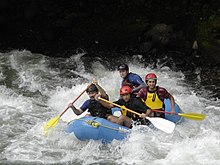White water paddling

Whitewater paddling is a form of canoeing in which whitewater is driven in a whitewater canoe or raft . The difficulty is differentiated according to the six-stage whitewater difficulty scale , whereby the amount of water ( flow ), gradient and (injury) risks or dangers play a role here. The tactical assessment of rapids or cataracts, eddies , falls , cascades , rollers , underwashes, currents and other places in the white water is important.
As a popular sport, whitewater paddling is practiced for sheer pleasure, including river running, creeking, squirt boating and play boating (canoeing), but also in some forms of competition (for brief descriptions of the respective boat types, see whitewater canoe ). Competitions on whitewater are organized in the disciplines whitewater racing , canoe slalom , extreme racing, squirt boating and freestyle (competition form of play boating). Some whitewater paddlers also refer to extreme whitewater paddling as »going down«, which reflects the character of the rivers they travel: steep, blocked, massive. In a narrower sense, “falling” means driving over waterfalls.
Whitewater paddling can be dangerous if you don't take safety precautions. As a rule, it is essential to equip yourself with a life jacket and helmet . Depending on the situation - especially for paddlers who drive alone or in a responsible position - a chest strap with a short safety line ( cowtail ) can also be useful for the life jacket, as well as a throw bag with throw line, snap hook and rescue knife . Safety training is also recommended for driving on routes with higher levels of difficulty.
In addition to natural waters, whitewater paddlers are increasingly using artificial stretches of whitewater facilities such as the Augsburg Ice Canal .

